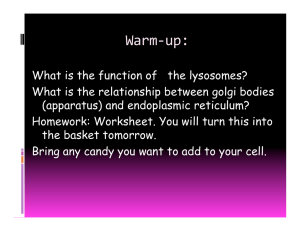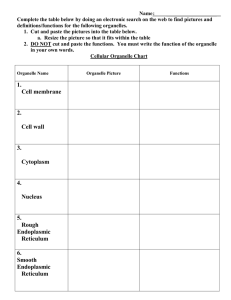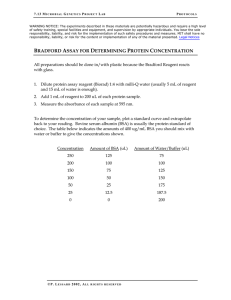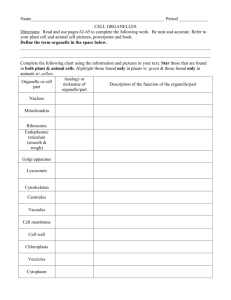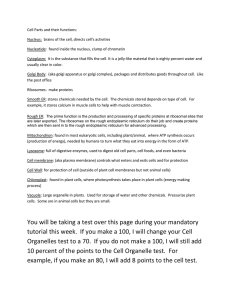ab139485 CytoPainter Golgi/ER Staining Kit Instructions for Use
advertisement
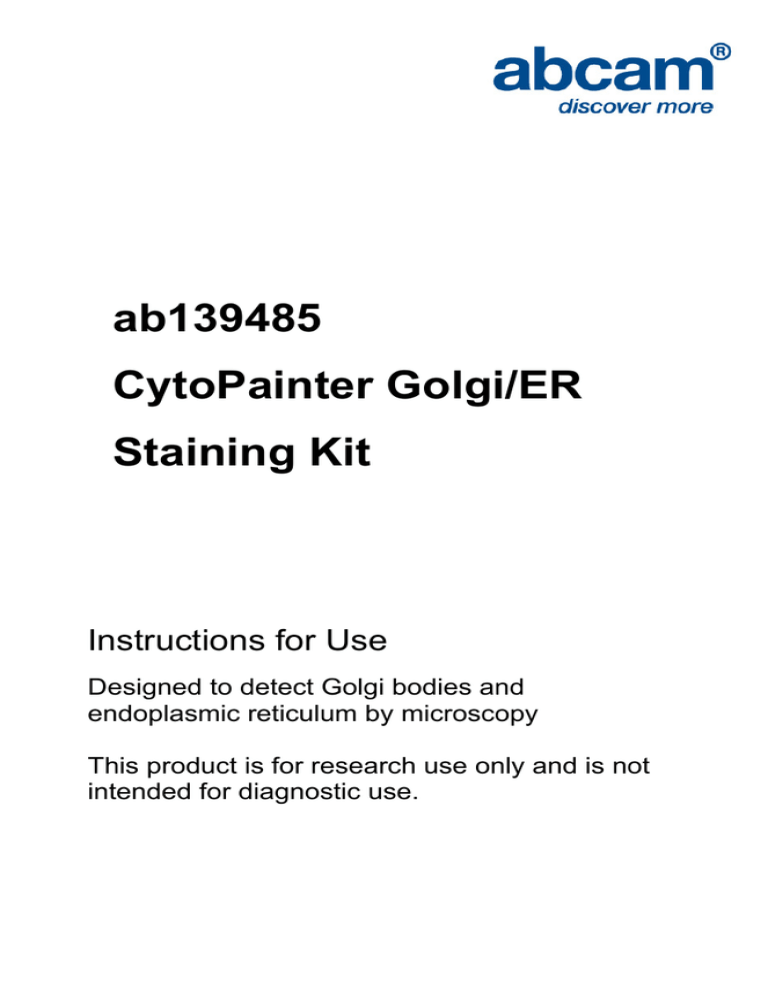
ab139485 CytoPainter Golgi/ER Staining Kit Instructions for Use Designed to detect Golgi bodies and endoplasmic reticulum by microscopy This product is for research use only and is not intended for diagnostic use. 1 Table of Contents 1. Introduction 3 2. Product Overview 4 3. Components and Storage 5 4. Pre-Assay Preparation 7 5. Assay Protocol 8 6. Data Analysis 12 7. Troubleshooting 13 2 1. Introduction The endoplasmic reticulum (ER) and Golgi apparatus (GA) are the primarily organelles responsible for the proper sorting of lipids and proteins within cells. Direct membrane continuity between these organelles has been established using different analytical methods, ranging from reconstruction of serial sections in transmission electron microscopy to functional analysis of the transport process itself. After synthesis, folding and quality control, the lipid and protein cargo exits from the ER and enters the GA through the ER-Golgi interface. Within the ER-Golgi interface, COPII-mediated concentration of membrane and soluble cargo occurs and various posttranslational modifications take place prior to delivery to the GA, including O-glycosylation, acylation, palmitoylation and mannose-6phosphate attachment (lysosomal targeting signal). Transient ERGolgi connections are likely to serve a role in the diffusion of cargo proteins as well as the recycling of organelle-resident proteins. The structure and functions of the various compartments along the secretory pathway are considered complicated and tools for the simple visualization and unambiguous categorization of the ER and GA in living cells have been lacking. 3 2. Product Overview ab139485 assay kit contains GA selective, ER-selective and nucleus-selective dyes suitable for live cell staining. Compared with other commercially available dyes for labelling Golgi bodies, the green dye component of the detection reagent is more faithfully localized to the Golgi apparatus, with minimal staining of the endoplasmic reticulum. The red dye component of the reagent stains the endoplasmic reticulum with high fidelity and is specifically designed for use with green fluorescing probes. ab139485 has been validated with Human cervical carcinoma cell line, HeLa, Human Tlymphocyte cell line, Jurkat, Canine kidney cell line MDCK and Human bone osteosarcoma epithelial cell line U2OS. The kit should also be suitable for identifying Golgi body and endoplasmic reticulum perturbing agents and thus can be a useful tool for examining the transport and recycling of molecules from the GA to ER in cellular secretory pathways. 4 3. Components and Storage A. Kit Contents Item Quantity Storage Temperature Organelle Reagent III (lyophilized) 1 vial ≤ -20°C 10X Assay Buffer 1 15 ml ≤ -20°C 1.2 ml ≤ -20°C 50X Assay Buffer 2 Reagents provided in the kit are sufficient for 100 microscopy assays using live cells (adherent or in suspension). 5 B. Storage and Handling Upon receipt, the kit should be stored upright at ≤-20°C, protected from light. Avoid repeated freezing and thawing. C. Additional Materials Required Standard fluorescence microscope Calibrated, adjustable precision pipets, preferably with disposable plastic tips Adjustable speed centrifuge with swinging buckets (for suspension cultures) Glass microscope slides Glass cover slips (18 x 18 mm) Deionized water Anhydrous DMSO (optional). Growth medium (e.g. Dulbecco’s Modified Eagle medium, DMEM) 6 4. Pre-Assay Preparation NOTE: Allow all reagents to thaw at room temperature before starting with the procedures. Upon thawing, gently hand-mix or vortex the reagents prior to use to ensure a homogenous solution. Briefly centrifuge the vials at the time of first use, as well as for all subsequent uses, to gather the contents at the bottom of the tube. A. Reagent Preparation 1. 1X Assay Solution Allow the 10X Assay Buffer 1 and the 50X Assay Buffer 2 to warm to room temperature. Make sure that the reagents are free of any crystallization before use. Prepare enough 1X Assay Solution for the number of samples to be assayed. For each 10 mL preparation of 1X Assay Solution, add 1 mL 10X Assay Buffer 1 and 0.2 mL 50X Assay Buffer 2 into 8.8 mL deionized water. Mix well. 2. Organelle Reagent III Solution a. 100X Organelle Reagent III. Add 100 μL of freshly prepared 1X Assay Solution (from step 1) to the vial containing lyophilized Organelle Reagent III. Vortex gently or slowly rotate the tube to dissolve. This re-suspended reagent may be stored at –20°C for up to 3 months. 7 b. 1X Organelle Reagent III. Add 10 μL of 100X Organelle Reagent III solution (from step 2a, above) per 1 mL of freshly prepared 1X Assay Solution (from step 1). Mix well. 5. Assay Protocol Staining live, adherent cells 1. Grow cells on 18 x 18 mm coverslips, or tissue culture treated slides, inside a Petri dish filled with the appropriate culture medium. When the cells have reached the desired level of confluence, carefully remove the medium. 2. Wash the cells with 100 μL 1X Assay Solution. 3. 3Dispense 100 μL of 1X Organelle Reagent III to cover the monolayer. 4. Protect samples from light and incubate for 30 minutes at 4°C. 5. Wash the cells 3 times using 100 μL ice cold medium for each wash. 6. Add fresh ice cold medium and incubate the cells at 37°C for 30 minutes. 7. Wash the cells with 100 μL 1X Assay Solution. Remove excess buffer and place coverslip on slide. 8 8. Analyze the stained cells by wide-field fluorescence or confocal microscopy (60X magnification recommended). Use a standard FITC filter set for imaging the Golgi bodies, a DAPI filter set for the nucleus and a Texas Red filter set for the endoplasmic reticulum. Staining live cells grown in suspension 1. After growth, centrifuge cells for 5 minutes at 400 x g at room temperature (RT) to obtain a cell pellet. 2. Carefully remove the supernatant by aspiration and then wash the cells with 200 μL of 1X Assay Solution. 3. Carefully remove the supernatant by aspiration and then add 100 μL of 1X Organelle Reagent III to the cell pellet. 4. Protect samples from light and incubate for 30 minutes on ice. 5. Wash the cells 2 times using 200 μL ice cold medium for each wash. 6. Re-suspend the cells in 100 μL ice cold medium and then incubate the cells at 37°C for 30 minutes. 7. Wash the cells with 200 μL 1X Assay Solution. 8. Re-suspend cells in 100 μL 1X Assay Solution, then transfer the cells to a glass slide and overlay with a coverslip. 9 9. Analyze the stained cells by wide-field fluorescence or confocal microscopy (60X magnification recommended). Use a standard FITC filter set for imaging the Golgi bodies, a DAPI filter set for the Nucleus and a Texas Red filter set for the endoplasmic reticulum. Filter set selection The selection of optimal filter sets for a fluorescence microscopy application requires matching the optical filter specifications to the spectral characteristics of the dyes employed in the analysis (see Figures 1-3 for the spectra of the dyes, all spectra were determined in 1X Assay Solution). Consult the microscope or filter set manufacturer for assistance in selecting optimal filter sets for your microscope. Figure 1. Fluorescence excitation and emission spectra for the green dye. 10 Figure 2. Fluorescence excitation and emission spectra for the red dye. Figure 3. absorbance and fluorescent emission spectra for the blue dye. 11 6. Data Analysis Upon staining with the Organelle Reagent III, the nucleus should fluoresce blue, as detected with a DAPI filter set. The Golgi apparatus should exhibit prominent green fluorescence, appearing as a perinuclear reticular network within the cell, when employing a FITC filter set. The endoplasmic reticulum should fluoresce red using a Texas Red filter set. (see Figure 4). Only minor staining of other membranes within the cell should be observed. Figure 4. ab139485 kit staining of MDCK epithelial cells. The ER (red), Golgi (green) and nuclear (blue) dyes highlight their respective subcellular targets with high dependability. 12 7. Troubleshooting Problem Potential Cause Suggestion Organelles not Very low sufficiently stained. concentration of increase the labeling Organelle concentration or limit Reagent III was used the time allowed for or cells were the cells to grow incubated too long after the dye has after labeling. been removed. We Either recommend labeling for 30 minutes and incubating cells for 30 minutes after the label has been removed. Precipitate is seen in Precipitate Allow solution to the 10X Assay Buffer forms at low warm to room 1. temperatures. temperature or 37°C, then vortex to dissolve all precipitate. 13 The blue nuclear Different Shorten the counter- stain is too microscopes, exposure time. bright compared to cameras and filters the green Golgi may make some stain. signals appear very bright. The green Golgi dye Excess Golgi green Reduce the appears to stain dye was used or concentration of more than just the cells were not Organelle Reagent Golgi bodies. washed well enough III and/or add after staining with additional washes medium containing with ice cold medium serum. (containing 10% serum) and extend the incubation time in medium after staining. The organelles are The Organelle Use the stain only for not properly stained Reagent III dye is live- cells analysis. in fixed cells. only suitable for livecell staining. 14 15 16 17 18 UK, EU and ROW Email: technical@abcam.com Tel: +44 (0)1223 696000 www.abcam.com US, Canada and Latin America Email: us.technical@abcam.com Tel: 888-77-ABCAM (22226) www.abcam.com China and Asia Pacific Email: hk.technical@abcam.com Tel: 108008523689 (中國聯通) www.abcam.cn Japan Email: technical@abcam.co.jp Tel: +81-(0)3-6231-0940 www.abcam.co.jp 19 Copyright © 2012 Abcam, All Rights Reserved. The Abcam logo is a registered trademark. All information / detail is correct at time of going to print.


